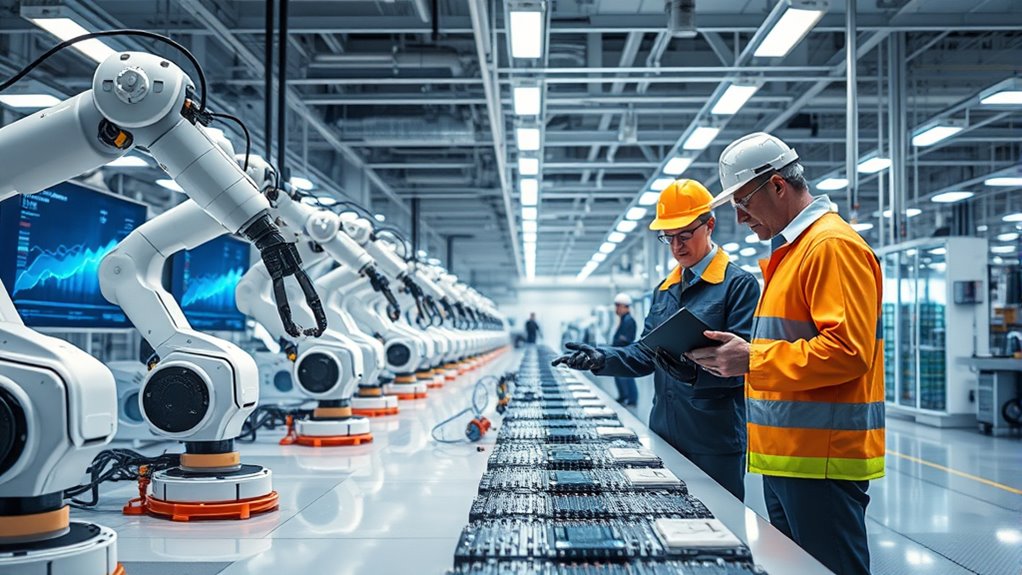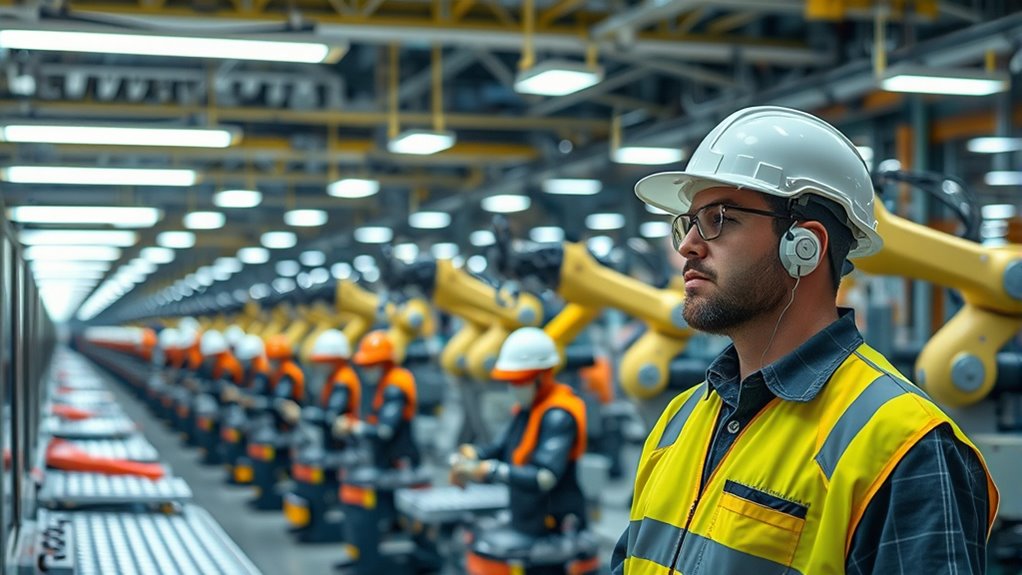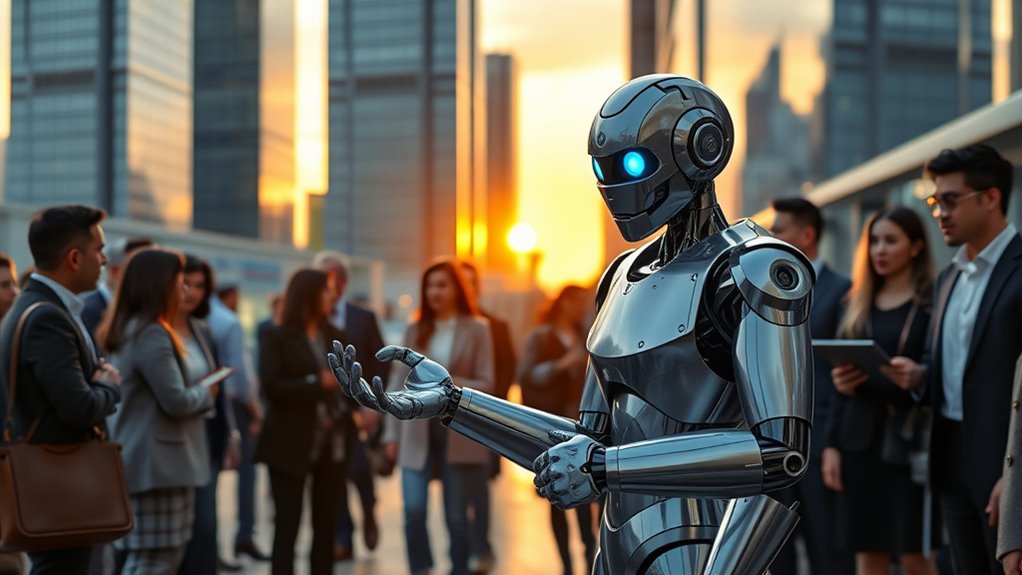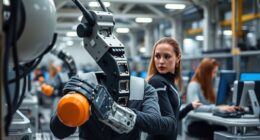Automation is transforming industries, but not every job will vanish. Many roles will evolve or shift, requiring new skills, especially in creative, strategic, or emotional tasks that AI can’t easily handle. Routine and repetitive jobs are most at risk, but others will adapt alongside technology. If you want to understand which jobs are most affected and how to prepare for these changes, keep exploring the bigger picture of industry shifts and workforce transformation.
Key Takeaways
- Not all jobs are equally automatable; routine and predictable tasks face higher automation risks, while creative and complex roles are less vulnerable.
- Current automation trends suggest significant job displacement, but also the creation of new roles requiring advanced skills.
- Many industries are investing in workforce retraining and human augmentation, emphasizing collaboration between humans and machines.
- Complete automation of every job is unlikely due to technical, ethical, and practical limitations.
- Future work will likely involve a hybrid of human and AI collaboration rather than total job elimination.
The Scope of Automation in Different Industries

Automation is transforming industries at a rapid pace, affecting a wide range of sectors differently. More than a third of all business tasks are now performed by machines, signaling a major shift. In energy, utilities, and mining, over 46.5% of jobs face high automation risk by 2030. Advancements in robotics and AI are fueling this change, with 58% of companies investing in these technologies. Manufacturing has seen the loss of 1.7 million jobs since 2000, but also increased productivity through automation. Meanwhile, service industries are automating routine tasks and integrating AI to improve customer experiences. Globally, industries are investing heavily in automation and human augmentation, creating new opportunities even as some roles become obsolete. The scope varies widely, shaping the future of work across sectors. Understanding the refrigeration cycle and its automation potential can help industries optimize their processes and adapt to technological changes. Recognizing the importance of employee engagement and skill development can also facilitate smoother transitions during automation implementation. Additionally, the integration of advanced control systems plays a crucial role in maximizing efficiency and precision in automated processes. As the cultural perception of automation continues to evolve, organizations can better manage change and foster innovation. Staying informed about business pitfalls and implementing effective strategies can prevent costly mistakes during this transition.
Which Jobs Are Most at Risk of Replacement?

Jobs involving routine, repetitive tasks are most vulnerable to being replaced by AI and robotics. Tasks like data entry, processing, customer service, and basic bookkeeping are prime targets. For example, 69% of data processing tasks could already be automated, and 95% of customer interactions may soon be AI-driven. Manufacturing roles, especially on assembly lines, are also at high risk, with up to 20 million jobs potentially displaced globally by 2030. Here’s a quick look:
| Job Type | Automation Risk | Estimated Displacement |
|---|---|---|
| Data entry clerks | Very high | 69% of tasks |
| Customer service reps | Very high | 95% of interactions |
| Bookkeepers/Accountants | High | 25.4% at risk |
| Manufacturing workers | High | 20 million by 2030 |
These jobs are most at risk because they involve predictable, repetitive tasks. Additionally, understanding psychological research can help workers develop skills that are less susceptible to automation, emphasizing the importance of adaptability and continuous learning. Developing skills in areas such as creativity, complex problem-solving, and emotional intelligence can provide a competitive advantage in the evolving job market. Moreover, cultivating resilience and flexibility can help workers navigate rapid technological changes more effectively. Furthermore, staying informed about emerging technologies can help workers anticipate shifts and adapt their skill sets proactively. Recognizing the significance of lifelong learning is crucial for maintaining relevance in an automated future.
The Impact of AI on Employment and Wage Trends

As AI continues to advance, its influence on employment and wages becomes increasingly apparent. You’ll notice a rapid growth in AI-related jobs, especially in creative and security sectors, despite overall job market slowdowns. Skilled workers like software developers are in higher demand, with employment expected to rise nearly 18% by 2033. However, around 40% of employers plan workforce reductions where AI can automate tasks, leading to displacement. While AI may replace 9 million jobs globally, it’s also creating 11 million new ones, shifting the job landscape. Salaries for remaining roles are often lower, and economic uncertainty slows hiring. Meanwhile, sectors like manufacturing face automation-driven layoffs, while fields like security see growth. Your career prospects depend on adaptability and continuous upskilling amidst these evolving trends. Additionally, Private Placement Equity Markets offer alternative funding avenues for companies seeking to innovate and grow in this changing environment. Furthermore, advancements in GMC tuning demonstrate how technology can be harnessed to improve vehicle performance, which parallels how AI can optimize various industries, including employment sectors. Staying informed about automotive tuning innovations can provide insights into how technological advancements influence various fields.
Advancements in Technology and Their Role in Job Transformation

Advancements in AI, robotics, and information processing are rapidly transforming industries and reshaping job roles. You’ll see significant shifts in sectors like energy, manufacturing, and retail, with many tasks becoming automated. Understanding these technological progressions helps you grasp how job landscapes are evolving across different regions and industries. Broadening digital access is expected to transform 60% of businesses by 2030, further accelerating the pace of change and automation across the workforce. Moreover, the development of advanced AI models like GPT-4 highlights both the potential and the vulnerabilities of automation, emphasizing the importance of AI trustworthiness in shaping future employment trends. As automation becomes more sophisticated, the importance of essential skills such as critical thinking, creativity, and emotional intelligence will only grow to complement technological advancements. Additionally, the rise of specialized automated tools tailored for specific industries underscores the increasing need for workforce adaptability and continuous learning. Staying informed about technology adoption trends is crucial for workers aiming to remain competitive in this evolving landscape.
Rapid AI Progress
Rapid progress in AI technology is transforming workplaces at an unprecedented pace, with new tools and systems being adopted across industries faster than ever before. Generative AI is projected to handle over 30% of work tasks for 34% of employees by 2025, while structured automation is expected to grow from 20% in 2021 to 70% in 2025. Many IT leaders believe AI will boost customer service and improve complex environment management. Here’s a quick snapshot:
| Area | Growth/Impact |
|---|---|
| Generative AI Usage | 30% of tasks by 34% of employees in 2025 |
| Automation Adoption | From 20% to 70% in 2025 |
| IT Automation | 88% enable end-user automation |
| Job Transformation | 23% of jobs expected to change by 2027 |
This rapid progress is reshaping how work gets done and the skills you’ll need. As AI continues to evolve, organizations are investing heavily in training and reskilling programs to prepare their workforce for these ongoing changes. A key factor driving this transformation is the market growth projected at over 40% CAGR in AI tech by 2025. Additionally, the increasing demand for automated solutions is prompting companies to rethink traditional workflows and operational models, especially as concerns over data privacy challenges become more prominent. The rise of electric bikes and generators highlights how technological advancements are improving sustainability and efficiency across various sectors. Furthermore, ongoing research into human-AI collaboration is essential to ensure these technological shifts benefit both organizations and their employees.
Industry-Specific Shifts
Technological breakthroughs are reshaping industries in ways that directly impact jobs across sectors. In energy, utilities, and mining, nearly half of jobs face high automation risk by 2030, while manufacturing has already lost 1.7 million jobs to automation. Retail could see up to 41 million jobs at risk by 2040. Managerial roles aren’t spared—69% of tasks could be fully automated by 2024. These shifts aren’t uniform worldwide; advanced economies see around 60% of jobs at risk, compared to just 26% in low-income countries. Automation is also changing skill demands, pushing workers to adapt quickly. Industries must evolve to stay competitive, and workforce development becomes essential. While some jobs disappear, new opportunities in AI and tech-related fields are emerging, shaping a complex, industry-specific future.
Opportunities for New Job Creation and Workforce Reskilling

As automation and AI continue to evolve, new job opportunities are emerging alongside the displacement of existing roles. Experts estimate that 20 to 50 million new jobs could be created globally by 2030, fueling economic growth and innovation. These roles will shift the job market toward technology-driven positions, emphasizing skills in AI, robotics, and software development. To meet this demand, workforce reskilling is vital—around 20 million workers are expected to retrain in new careers within the next three years. Educational institutions are adapting to provide relevant training, while initiatives focus on closing the growing skills gap. Although automation displaces many jobs, the expansion of new roles offers a pathway for workers to adapt, thrive, and contribute to a dynamic, tech-driven economy. Additionally, the importance of best vacuums for dust removal in 2024 highlights how technological advancements continue to enhance household efficiency and indoor air quality. Understanding the juice manufacturing process and its stages can serve as a metaphor for how industries evolve through technological advancements and adaptation, especially when combined with smart marketing strategies that help businesses stay competitive.
How Different Age Groups View Automation

Different age groups experience and perceive automation in distinct ways, shaped by their roles in the workforce and exposure to new technologies. Younger workers, especially aged 18-24, often face higher automation exposure, with 41% in sectors like food service. They report more personal impacts, such as job losses (6%) and pay cuts (11%). In contrast, older workers tend to be less affected directly but face wage plateaus and job insecurity due to automation-driven labor shortages and demographic shifts. Their attitudes may be more cautious or resigned. Here’s how these differences look:
| Age Group | Automation Impact | Perception of Career | Sentiment Toward Technology |
|---|---|---|---|
| 18-24 | High exposure, job loss | Negative, career concerns | More pessimistic |
| 25-40 | Moderate impact | Mixed feelings | Slightly optimistic |
| 41-56 | Lower impact | Neutral | Cautiously optimistic |
| 56+ | Least impacted directly | Worries about job security | Generally wary |
The Timeline for Widespread Automation Adoption

Automation is rapidly transforming industries, with businesses increasingly adopting new technologies to improve efficiency and reduce costs. You’ll see automation accelerate over the next few years, especially in manufacturing and data entry, where millions of jobs are at risk. By 2025, AI will handle over 30% of daily tasks in the US, and two million manufacturing roles could be replaced. Globally, AI might displace 300 million jobs by 2050, with about 20% of jobs affected worldwide. The biggest shifts are happening now, with the automation of routine tasks and the emergence of humanoid robots by 2026. The timeline suggests significant change by the late 2020s and into the 2030s, as AI systems become more autonomous and capable of self-improvement, reshaping the workforce at an unprecedented pace.
Industry Transformation Beyond Manufacturing

Automation’s reach extends well beyond manufacturing, reshaping a wide range of industries. Over a third of all business tasks are now performed by machines, impacting sectors like energy, utilities, and services. In advanced economies, 60% of jobs face automation risks, with 14% already displaced by AI. The global human augmentation market is projected to hit $492 billion by 2025, reflecting rapid technological growth. Industries such as energy and utilities are automating core tasks, with nearly half of jobs at high automation risk by 2030. The service sector is increasingly adopting AI for customer interactions and data analysis, creating new roles while displacing others. Employers plan extensive retraining efforts—77% aim to prepare workers for AI collaboration—highlighting industry-wide shifts and the need for adaptable skill sets.
Frequently Asked Questions
Will Automation Eliminate All Low-Skill Jobs in the Future?
You might wonder if automation will wipe out all low-skill jobs in the future. While many repetitive roles are at high risk, not every low-skill job will disappear. Some roles require human interaction, creativity, or decision-making that automation can’t replicate. To stay competitive, you’ll need to adapt by developing new skills, especially in tech-related fields, ensuring you remain valuable even as automation evolves.
How Can Workers Prepare for Automation-Related Job Changes?
You can prepare for automation-related job changes by upskilling in areas less likely to be automated, like creativity and critical thinking. Embrace continuous learning to stay current with new technologies, including AI tools. Be adaptable, open to new roles, and network to discover opportunities. Investing in your skills now helps you stay relevant, increases your employability, and allows you to thrive even as automation reshapes the job landscape.
Are There Industries Resistant to Automation’s Impact?
You might wonder if some industries can resist automation’s impact. Many sectors, like healthcare, education, legal, and skilled trades, are less vulnerable because they rely on complex tasks, human judgment, empathy, or practical skills. These jobs require nuanced decision-making and personal interaction that technology can’t easily replicate. So, if you’re in one of these fields, you’re better positioned to stay relevant despite ongoing automation trends.
What Role Will Government Policies Play in Managing Automation Risks?
Did you know over 400 AI-related bills were introduced in 2024? Government policies will play a crucial role in managing automation risks by setting standards for transparency, bias prevention, and human oversight. State-led regulations, like California’s “No Robo Bosses Act,” aim to protect workers from harmful automation, while federal efforts are still evolving. Your compliance with these policies will be essential to balancing innovation and fair employment practices.
Can AI Create More Jobs Than It Replaces?
You might wonder if AI can create more jobs than it replaces. While AI could displace up to 300 million jobs worldwide, it’s also expected to generate around 97 million new roles by 2025, especially in emerging sectors. If you stay adaptable and invest in new skills, you’ll likely find opportunities in AI-supported industries. Embracing change helps you benefit from AI’s potential to boost employment rather than diminish it.
Conclusion
So, buckle up, because automation isn’t just changing jobs—it’s rewriting the entire rulebook of work. Picture a world where robots rule the factories, AI takes over your favorite coffee shop, and humans become legends of creativity and empathy. It’s a future where every job could be transformed into something unrecognizable, like a sci-fi movie come to life. Stay adaptable, or you might just wake up in a world where human hands are a thing of the past!









